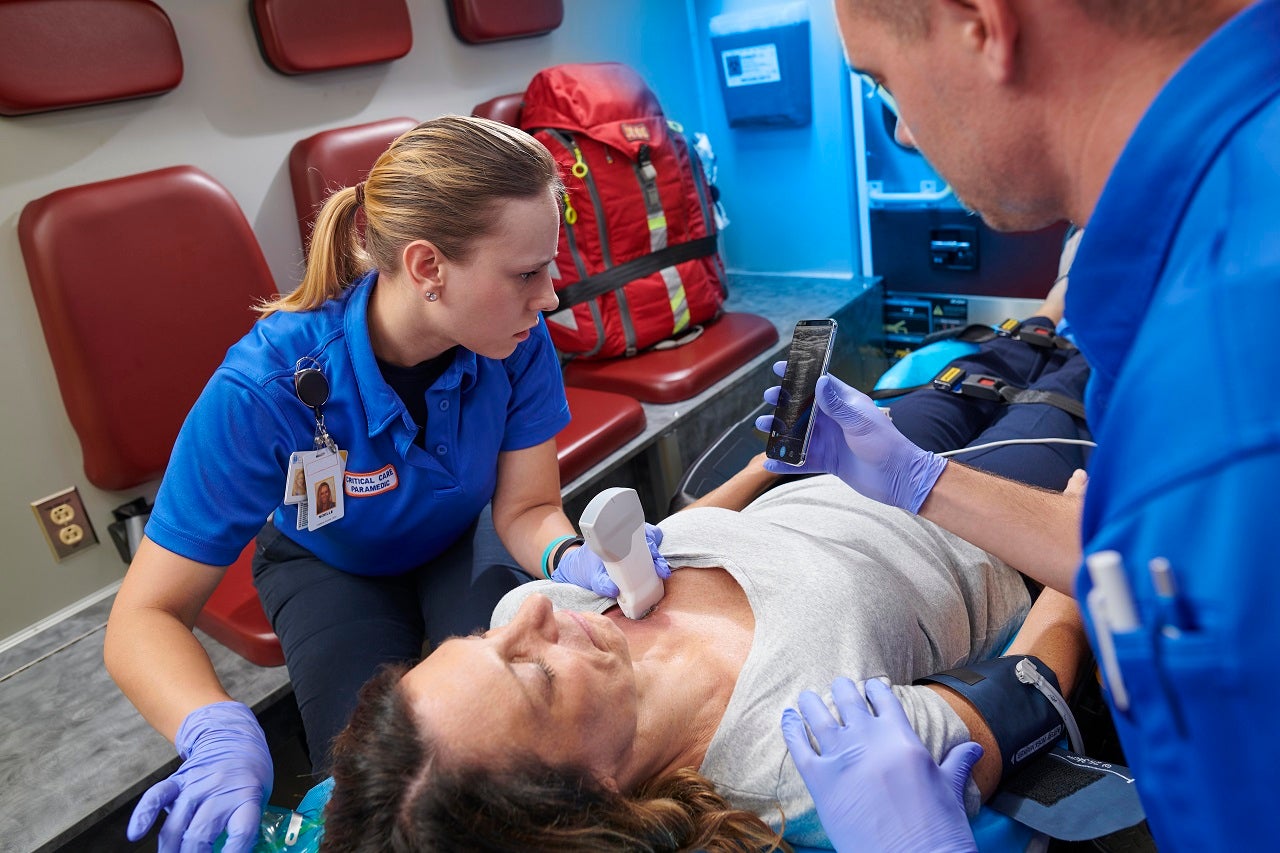
GE Healthcare recently unveiled Vscan Air, a wireless, pocket-sized ultrasound device with the potential to revolutionise the way sonographic procedures are carried out. Building on the design of the company’s first full-colour portable ultrasound, which was released over a decade ago, Vscan Air allows clinicians to carry out ultrasound scans at multiple stages in a patient’s care journey – including at their very first assessment.
The battery-powered Vscan Air device is intended for use by healthcare professionals conducting diagnostic ultrasound imaging and fluid flow analysis, connecting to a companion app on the user’s mobile phone. The dual-headed probe allows users to switch seamlessly between shallow and deep exams across the entire body, while the app allows them to quickly store and share anonymised images with colleagues.
The device can help clinicians assess illnesses in numerous care settings, rather than requiring specialist referral. In remote, resource-limited areas, where opportunities for an ultrasound scan in a hospital may be scarce, handheld ultrasound provides a vital resource to both patients and their caregivers. Even in cases where hospital ultrasound is available, wait times can be long and the results of a handheld examination can help speed up the process. Devices such as Vscan Air – along with the likes of Clarius’s C3 HD wireless scanner and the Sonosite Edge II – bring ultrasound capability out of specialist care centres and into the doctor’s office.
GE Healthcare product manager Steffen Mueller says: “People are really surprised that their point-of-care physician is taking this inside look. Typically, they’re referred to an ultrasound exam and sometimes have to wait quite a while. Here, it’s incorporated when their primary care physician sees them on their first visit.
“My wife was in such an exam and the doctor identified a suspicious narrowing of one of the carotid arteries, vessels which supply the brain with blood. This finding resulted in a referral to an angiography and that identified a sub-total occlusion, a severe narrowing of the blood vessel. It couldn’t be heard with a stethoscope, there’s no way you can feel it. This very personal experience inspired my team and myself, as an example of how powerful this inside look into the patient body can be.”
Why is handheld ultrasound so important now?
As a result of the Covid-19 pandemic, clinicians worldwide are treating more critically ill patients than ever before, while battling limitations in staff, time and resources. Handheld ultrasound has thus become an essential tool to allow clinicians to quickly collect images and triage patients while also providing the benefits of portability, cleanability and workflow efficiency. When assessing Covid-19 patients in hospital, for example, handheld lung ultrasound devices can help a doctor determine the severity of a patient’s condition with minimal lag.
How well do you really know your competitors?
Access the most comprehensive Company Profiles on the market, powered by GlobalData. Save hours of research. Gain competitive edge.

Thank you!
Your download email will arrive shortly
Not ready to buy yet? Download a free sample
We are confident about the unique quality of our Company Profiles. However, we want you to make the most beneficial decision for your business, so we offer a free sample that you can download by submitting the below form
By GlobalDataThe fact that these devices are so much easier to clean also gives them an edge over traditional ultrasound as the pandemic continues. Vscan Air is waterproof and compatible with high-level disinfection protocols, making it suitable to use in high-volume healthcare settings where the device needs to quickly be passed from patient to patient.
Mueller says: “Even if you can move a large machine into an intensive care unit, it’s so difficult to try and disinfect it afterwards. It’s a nightmare. With these small devices, you can easily clean them.”
Handheld ultrasound is making waves
Vscan Air has now been launched across the US and most of Europe, with plans to expand further in the coming months. Going forward, Mueller says GE Healthcare is looking into how it could use AI and automation as part of its ultrasound portfolio, alongside cloud-based solutions and tweaks to the device’s probe. With ultrasound increasingly becoming part of the primary care toolkit, automation could help guide users who may not have the advanced training that comes in specialist units.
“Quite a few investigations are underway under the buzzword of artificial intelligence,” he says. “Automated workflow solutions can be used for user guidance, to help do a good scan and interpret the images. Cloud-based services are also very much under discussion. We also expect that there might be specialised probes for specialised areas and other broad application solutions.”
The Vscan brand has been a significant player in the handheld ultrasound market over the past decade, and GE Healthcare says it has placed more than 30,000 devices with clinicians in over 100 countries during this time. However, the company faces some stiff competition.
Butterfly Health Network, manufacturer of the Butterfly iQ point-of-care ultrasound device, recently closed a merger with SPAC Longview Acquisition and is now valued at over $3bn. A number of start-ups are also focusing on portable ultrasound systems, with Exo raising $40m for its device in August last year and artificial intelligence (AI) ultrasound startup Caption Health closing a $53m series B round in July.






